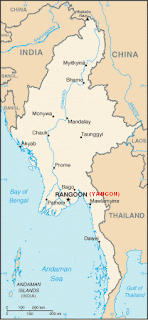Rabindranath Tagore to China (Rangoon-1-2-3)
Rabindranath Tagore to China (Rangoon-1)
Tagore visited Burma three times during the colonial period. He visited Shwedagon Pagoda on May 5, 1916, and Indians in Rangoon celebrated his birthday on May 8 that year at Jubilee Hall in Rangoon. He attended the “Bengali Literature Conference” held in Rangoon on March 24, 1924, and stayed in Rangoon for four days. An inscription engraved in both Burmese and English marks his visit to a building at No. 392-396 Merchant Street, Rangoon, on the east wall of “Guardian Magazine.” He also visited Burma from October 22-24, 1927, for the Dewali Festival.
During his first visit, he noted that Indians were a majority and Burmese were a minority in Rangoon. He wrote, “Burma did not look like Burma when I reached there. Rangoon just exists on a map and it’s as if it didn’t really exist on the ground. In other words, the city does not look like a tree growing from the ground, it looks like a bubble drifting in the water.”
Admirers of Tagore’s literature established the “Burma- Tagore Association” in 1952. Burmese writer Paragu translated at least five books by Tagore. Many of his poems and stories were translated by other writers including Maung Phyu, Zaw Gyi, Min Thu Wun, Mya Than Tint, Myint Soe Hlaing and Hein Latt.
The well-known works of Tagore in Burmese are Gitanjali, Gardener, Stray Birds, and Picking Fruits and Sitra.
On 24th March, 1924, in the morning at about 8 AM before the ship touched the shore and could anchor, some important members of reception committee came to the ship by a steamer and accorded welcome to Rabindranath. The ship having reached the shore a renowned businessman J.A.K.Jamal garlanded Rabindranath and a Burmese lady offered a bunch of flowers to him to welcome him. Then they fetched Rabidranath to a beautiful house at Bigonded Street.The Governor of Burma Sir Harcourt Butler greeted them to offer a lunch. The diary of Kalidas Nag noted that the invitation of the Governor of Burma and the Chinese Community, by this time, reached the ship by wire on 22 ndMarch..
Rabindranath Tagore to China ( Rangoon-2) – contd – 8
” We greet you in the name of that universal culture which you have promoted with admirable devotion and singleness of aim. We greet you in the name of Human Brotherhood, the inculcation of which in East and West has been with you a consuming passion. We greet you as a votary of Truth sensed through beauty. We greet you as one representing the rebirth of Asia, as one who has thrown across the chasm of ignorance and misunderstanding a bridge of future comprehension between Asia and Eur-America. We greet you as the lineal descendant of philosopher-seers of Ancient India, who at the dawn of civilization proclaimed the Unity of Life and knew Humanity for one family transcending barriers of race and clime.”
In reply to the Welcome address Rabindranath gave long speech ; He said;
” Every great nation have contributed something which happened to be the world’s treasure. In ancient time India established a relation with the rest of the world which was not based upon their trade or extension of their territory. That was based on some great ideals. In the glorified past of the nation the messengers of the religious and cultural field of India went to distant places and informed them that they had brought something which would help them to tie their friendship for ever. the great contribution of Hindu Philosophy is the strength of the unity.”
Elmhirst wrote to Rabindranath on 26th March;
” The local Gujrathi people wanted to utilize the occasion politically.”
Rabindranath Tagore to China (Rangoon-3)-contd-9
” In the background the head Teacher, Mohit Kumar Mukhopadhyay of a local Bengalee school named Bengal Academy and the litterateur Sudhir Kumar Choudhury was actively participating in construction of felicitation paper and arrangement of Welcome ceremony. They also arranged a dance programme performed by a Burmese lady.” Mohit Kumar was his elder brother and Sudhir Kumar , husband of Sita Devi (daughter of Ramananda) Viswabharati wrote on the dance programme of the Burmese lady in the Sahitya Sammilani;
“provided the best entertainment for the poet by organising a classical Burmese dance party to the accompaniment of Burmese orchestra dominated by a dainty Burmese Girl interpreting the delicate dance rhythms of Burma, which fascinated the poet and provoked the celebrated artist Nandalal Bose to draw a series of quick sketches while the dance was going on.”
Rabindranath wrote to Ranu;
” day before yesterday in the evening I witnessed a dance programme of a Burmese girl. Her dance was very sweet. it was as if the gentle breeze was blowing over the leaves sometimes from the east and sometimes from the south which was making it emotional.”
Kalidas Nag took the note of the lecture delivered by Rabindranath at the ceremony of Sahitya Sammilani.
The arrival of Rabindranath created eagerness among the residents of Rangoon about Viswabharati. To convert this eagerness into monitory benefit Elmhirst wanted to form a branch of Viswabharati Sammilani. With this object he wrote to Rathindranath to send immediately with Sudhir Kumar or Mohit Kumar the forms of ordinary members and life members and also the rules and regulations of Viswabharati Sammilani.






5 comments
kai
March 25, 2017 at 3:18 pm
https://books.google.com/books?id=-QXeCgAAQBAJ&lpg=PT84&ots=8Ua_uFCBXC&dq=Rabindranath%20Tagore%20rangoon&pg=PP1#v=onepage&q=Rabindranath%20Tagore%20rangoon&f=false
သျှားသက်မာန်
March 25, 2017 at 3:26 pm
အင်္ဂလိပ်စာတွေတအားရေးထားတာတော့ ကျော်ချသွားတယ်တို့ဘာတို ့
kai
March 25, 2017 at 3:44 pm
https://www.facebook.com/ScubaSom64/posts/10207243254874465
အဲဒီမှာသွားရေးထားတာ..
ဆိုတော့… အထောက်အထားတွေစုနေတာ.. ရန်ကုန်ဆိုတာ.. ကုလားမြို့တို့ဘာတို့..။ :k:
တကယ်ကတော့.. ကဗျာဆရာကြီးတဂိုး ရဲ့ ရန်ကုန်ဝေဖန်မှုကို.. စသိတာ.. ရွာသားကဘလှိုင်.. ကောင်းမှု..။ :k:
====================================
Thint Aye Yeik
March 25, 2017 at 11:40 pm
တဂိုးကတော့ တဂိုးပါပဲ။
နှစ်ဂိုး မရှိ
ဂျစ်စူ
March 28, 2017 at 10:06 pm
သဂျီးလာရင် မိုးကြိုးငှက်ငယ် အဖွဲ့ရဲ့ တိုင်ပတ်အကနဲ့ ဧည့်ခံမယ်